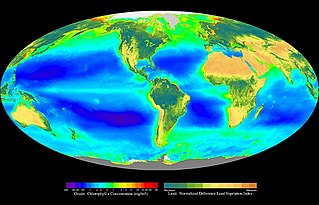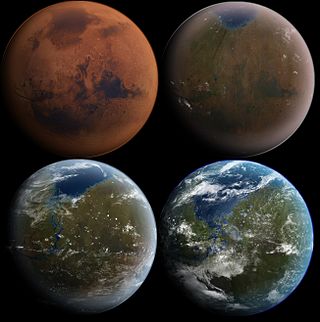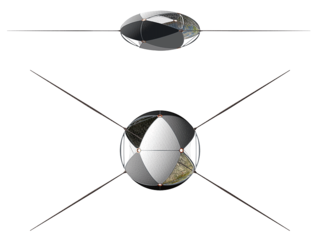
The biosphere, also known as the ecosphere, is the worldwide sum of all ecosystems. It can also be termed the zone of life on Earth. The biosphere is virtually a closed system with regard to matter, with minimal inputs and outputs. Regarding energy, it is an open system, with photosynthesis capturing solar energy at a rate of around 130 terawatts per year. By the most general biophysiological definition, the biosphere is the global ecological system integrating all living beings and their relationships, including their interaction with the elements of the lithosphere, cryosphere, hydrosphere, and atmosphere. The biosphere is postulated to have evolved, beginning with a process of biopoiesis or biogenesis, at least some 3.5 billion years ago.

A Dyson sphere is a hypothetical megastructure that encompasses a star and captures a large percentage of its solar power output. The concept is a thought experiment that attempts to imagine how a spacefaring civilization would meet its energy requirements once those requirements exceed what can be generated from the home planet's resources alone. Because only a tiny fraction of a star's energy emissions reaches the surface of any orbiting planet, building structures encircling a star would enable a civilization to harvest far more energy.

Terraforming or terraformation ("Earth-shaping") is the hypothetical process of deliberately modifying the atmosphere, temperature, surface topography or ecology of a planet, moon, or other body to be similar to the environment of Earth to make it habitable for humans to live on.

Biosphere 2 is an American Earth system science research facility located in Oracle, Arizona. Its mission is to serve as a center for research, outreach, teaching, and lifelong learning about Earth, its living systems, and its place in the universe. It is a 3.14-acre (1.27-hectare) structure originally built to be an artificial, materially closed ecological system, or vivarium. It remains the largest closed ecological system ever created.
This glossary of ecology is a list of definitions of terms and concepts in ecology and related fields. For more specific definitions from other glossaries related to ecology, see Glossary of biology, Glossary of evolutionary biology, and Glossary of environmental science.

A life-support system is the combination of equipment that allows survival in an environment or situation that would not support that life in its absence. It is generally applied to systems supporting human life in situations where the outside environment is hostile, such as outer space or underwater, or medical situations where the health of the person is compromised to the extent that the risk of death would be high without the function of the equipment.
BIOS-3 is an experimental closed ecosystem at the Institute of Biophysics in Krasnoyarsk, Russia.

The EcoSphere and "Original Ecosphere" are trademark names for sealed blown-glass miniature aquaria formerly produced by Ecosphere Associates, Inc., of Tucson, Arizona, United States. Spherical or ovoid, the aquaria range from roughly pool-ball-size to basket-ball-size. They are sold worldwide as scientific novelties and decorative objects.

Technogaianism is a bright green environmentalist stance of active support for the research, development and use of emerging and future technologies to help restore Earth's environment. Technogaianists argue that developing safe, clean, alternative technology should be an important goal of environmentalists.
Controlledecological life-support systems are a self-supporting life support system for space stations and colonies typically through controlled closed ecological systems, such as the BioHome, BIOS-3, Biosphere 2, Mars Desert Research Station, and Yuegong-1.

Globus Cassus is an art project and book by Swiss architect and artist Christian Waldvogel presenting a conceptual transformation of planet Earth into a much bigger, hollow, artificial world with an ecosphere on its inner surface. It was the Swiss contribution to the 2004 Venice Architecture Biennale and was awarded the gold medal in the category "Most beautiful books of the World" at the Leipzig Book Fair in 2005. It consists of a meticulous description of the transformation process, a narrative of its construction, and suggestions on the organizational workings on Globus Cassus.

The following outline is provided as an overview of and topical guide to Earth science:

The Micro-Ecological Life Support System Alternative (MELiSSA) is a European Space Agency (ESA) initiative with the aim to develop the technology for a future regenerative life support system for long-term human space missions. Initiated in 1989, the design is inspired by a terrestrial ecosystem. As of 2023, MELiSSA is a consortium made up of 30 organisations across Europe.

Biological organisation is the hierarchy of complex biological structures and systems that define life using a reductionistic approach. The traditional hierarchy, as detailed below, extends from atoms to biospheres. The higher levels of this scheme are often referred to as an ecological organisation concept, or as the field, hierarchical ecology.
Novel ecosystems are human-built, modified, or engineered niches of the Anthropocene. They exist in places that have been altered in structure and function by human agency. Novel ecosystems are part of the human environment and niche, they lack natural analogs, and they have extended an influence that has converted more than three-quarters of wild Earth. These anthropogenic biomes include technoecosystems that are fuelled by powerful energy sources including ecosystems populated with technodiversity, such as roads and unique combinations of soils called technosols. Vegetation associations on old buildings or along field boundary stone walls in old agricultural landscapes are examples of sites where research into novel ecosystem ecology is developing.
Bioregenerative life support systems (BLSS) are artificial ecosystems consisting of many complex symbiotic relationships among higher plants, animals, and microorganisms. As the most advanced life support technology, BLSS can provide a habitation environment similar to Earth's biosphere for space missions with extended durations, in deep space, and with multiple crews. These systems consist of artificial ecosystems into which plants and microorganisms that allow oxygen production, carbon dioxide fixation of carbon, water purification, waste recycling, and production of foods. In these systems, photosynthetic organisms would be used as plants and algae that provide biomass for food and oxygen, as well as microorganisms that degrade and recycle waste compounds generated by human activity, as well as unused plant debris in food.

Mark Nelson is an American ecologist and author based in Santa Fe, New Mexico. His research focuses on closed ecological system research, ecological engineering, restoration of damaged ecosystems, and wastewater recycling. The founding director of the Institute of Ecotechnics in 1973, Nelson was one of the eight original crew members of Biosphere 2 in 1991 and served as the Director of Earth and Space Applications for the project until 1994.

An ecosphere is a planetary closed ecological system. In this global ecosystem, the various forms of energy and matter that constitute a given planet interact on a continual basis. The forces of the four Fundamental interactions cause the various forms of matter to settle into identifiable layers. These layers are referred to as component spheres with the type and extent of each component sphere varying significantly from one particular ecosphere to another. Component spheres that represent a significant portion of an ecosphere are referred to as a primary component spheres. For instance, Earth's ecosphere consists of five primary component spheres which are the Geosphere, Hydrosphere, Biosphere, Atmosphere, and Magnetosphere.

Josef Isaevich Gitelson ; was a Soviet and Russian biophysicist. PhD in biology (1955), DrSc in medicine (1961), Professor, Member of the Russian Academy of Sciences (1991); Corresponding member of the USSR Academy of Sciences (1979), Member of the USSR Academy of Sciences (1990). Director of Institute of Biophysics, Siberian Branch of the Russian Academy of Sciences (1984-1996). Academic Advisor at this Institute since 1996. Scientific supervisor of Institute of Fundamental Biology and Biotechnology Siberian Federal University. Member of International Academy of Astronautics. Honorary Citizen of Krasnoyarsk Krai since Sept 20, 2013 and the city of Krasnoyarsk. In 2018, JI Gitelson was awarded the highest award of the Russian Academy of Sciences, Lomonosov Gold Medal for the justification and development of the ecological direction of biophysics, which has achieved a number of outstanding fundamental and practical results, in particular, in marine and laboratory studies of bioluminescence.














